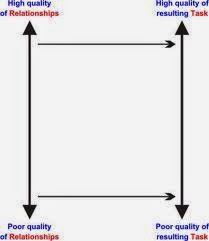A
topnotch HR Survey reports that only 1/3 of leaders reported
being
effective in
leading across countries and cultures. Despite this
being
one of
two skills ranked by HR professionals as most critical
for
the future,
organizations
are not focusing on it in current
leadership development programmes.
In
fact, only 1 in 5 organizations emphasize development in global
leadership.
Global Leadership Forecast
2014/2015
A serious situation given that
those that invest in building leaders’ skills in
the critical areas and whose leaders
are more effective as a result, are 3 times
more likely to rank in the top 20 percent for financial performance.
more likely to rank in the top 20 percent for financial performance.
In order to lead, a person must be
able to understand the basic motivation
of those being led – their
willingness to exert effort towards a goal. Patterns
of
motivation vary both between individuals and across cultures.
A case
study (adapted from HBR)
Akito, a Japanese teacher with
an outstanding track record of teaching
in a Japanese primary school,
won a scholarship to study at a well-known
university in New York. This
included the opportunity to teach part-time,
at a local high school,
conducting conversational Japanese lessons with
a tenth-grade class of
American students.
Being well educated in
Japanese culture and fluent in English, he reasoned
that he would be able to
get on the same wavelength as the
American teenagers.
However on his first day of
teaching, he had difficulty maintaining discipline
and getting their attention
when communicating clearly structured class objectives.
Transferring his Japanese
teaching experience to the American classroom,
he noticed that the teenagers
seemed bored and unwilling to participate.
On the way out of class, he
heard one student remark: “Boy, is he uptight!
He ought to chill
out.”
The problem Akito faces is one
of leadership. Leadership is the ability to
influence other people
to strive willingly to reach common goals.
Akito as the teacher of the
class, is also its leader. It is his job to get the class
interested in the common goal
of learning Japanese and influence them to
“strive willingly” toward the
goal. To do this, he needs to show them that
he cares about and understands them, that their success
will also be his.
Why hasn’t he
succeeded? It seems most likely that his style of leadership
was too Japanese to achieve a good
fit with the culture and expectations
of his American students. Japanese
have a higher level of power distance
than Americans and Japanese teachers
very naturally exercise authority over
students. Japanese children
are much more respectful of their teachers
and more willing to pay attention
without questioning. American children
expect their teachers to earn
respect through their actions. Akito might have
succeeded better with them had he
been less formal and taken time to get to
know them before launching into his
firmly-fixed class agenda.
In the multicultural workplace,
more and more managers find themselves
dealing with followers
who
are culturally different from themselves (and often
culturally different from each
other).
Using a structured framework
designed to support international teamwork step-by-step, I help managers to
develop the mindfulness and adaptability skills needed to delegate tasks, taking into account the diverse
characteristics of their followers. By varying their leadership styles accordingly, they will in the
process acquire the cultural intelligence necessary to drive and motivate
high-performing teams.
If you would like me to review how your team works,
please feel free to
contact me. We will walk through some of
the current challenges you may be facing in leading your
international teams and I will try to give you my best tips and ideas.
Christina Kwok
www.cross-culturalsynergies.com
ckwok@bluewin.ch





.png)